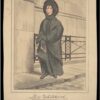
Rebecca Nesvet, “Miss Whitehead, ‘The Bank Nun’”
An urban legend maintains that early in the nineteenth century, one Miss Whitehead, colloquially known as “the Bank Nun,” frequently visited the Bank of England to accuse that institution of destroying her brother, a financial forger. This essay traces the evolution of this legend. I contend that in 1837, an obscure comic sketch reacted to that year’s major financial crisis by dredging up the Romantic-era case of financial forger Paul Whitehead and focusing on his surviving sister. Displacing her brother’s notoriety onto her, the sketch reinvents her as “the Bank Nun,” a grotesque magnet for lingering Romantic-era anxieties about the circulation of paper credit, financial forgery, and women. A succession of plagiarisms, retellings, and reappraisals of this ephemeral sketch and its portrait illustration made the Bank Nun a folk heroine of enduring resonance. Via this iconic figure, Romantic-era economic controversy haunts London today.
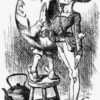
Jean Little, “Algebraic Logic in Through the Looking Glass”
This essay argues that Lewis Carroll’s Through the Looking Glass, which was published December 27, 1871, refers repeatedly to mathematics and logic in ways that, while certainly playful, reflect a careful thinking through of Boolean logic. Just as George Boole’s symbolic algebra relies on relational and oppositional binaries to create an internally coherent system, Through the Looking Glass experiments with binaries in their various forms, often using the numbers zero and one as placeholders for more complex ideas. This model of logic as a systematic grouping of concepts that could be represented numerically and visually would influence Carroll’s later work, culminating in Symbolic Logic (1896).
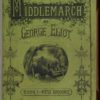
Jules Law, “Victorian Virtual Reality”
This entry considers the lines of continuity between certain aspects of Victorian popular culture and those turn-of-the-21st-century forms of (and aspirations to) real-time, immersive entertainment that we dub “virtual reality.” I argue that virtuality has two aspects, one historical and one phenomenological, and that the middle of the nineteenth century provided templates for both. Like several other scholars (most notably Clayton, Byerly and Plotz), I see the aspiration to virtuality manifested in realist as well as illusionistic genres. I trace virtuality to the Benjaminian concept of the “aura,” but offer a new reading of that term as an historical phase (with a terminal point) rather than as an historically produced essence.

Troy J. Bassett, “‘More than a Bookseller’: Iredale’s Library as the Center of Provincial Literary Life”
Andrew Iredale welcomed Her Royal Highness Princess Victoria and her cousins to his library in Toquay, Devon on 1 September 1898 where the group bought books and photographs. Founded by Iredale in 1872, Iredale’s Library became the “centre of literary life” in the seaside resort community well into the twentieth century. This article considers the circulating library’s role in the community: in addition to selling and lending books, the library served as a place for public and private meetings, third-party business transactions, and interpersonal networking. As the history of Iredale’s Library illustrates, provincial circulating libraries played a vital role in communities well beyond their money-making operations.
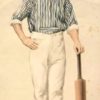
Joanne Wilkes, “The Implications of the Cricket Match in Anthony Trollope’s The Fixed Period (1882)”
Anthony Trollope’s late novel The Fixed Period (1882), set a century in the future in a fictional South Pacific island, has often puzzled readers. It deals with a policy of compulsory euthanasia in the politically independent island of Britannula, a policy that is overturned when the island is taken over by Britain. My article aims to explain an odd interlude in the novel: a cricket match in Britannula between a local and an English team. Drawing on the history of cricket matches between England and its antipodean colonies around the time of the novel’s composition, I argue that the cricketing interlude serves to highlight the text’s take on the Britannulans. This community, living a hundred years in the future, claims to be autonomous, but it possesses a mindset still governed by a sense of Britain as the “mother country.” Hence Trollope emphasizes how difficult it is for settler societies to shake off such attitudes and ties.
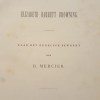
Karen Dieleman, “Aurora Leigh in the Netherlands, 1870-1900″
Elizabeth Barrett Browning’s 1857 verse-novel Aurora Leigh entered the cultural and social-political life of the Netherlands in the 1870s and 1880s through the work of three Dutch people: a literary critic, a social reformer, and a novelist. Conrad Busken Huet, the country’s leading literary and cultural critic, first brought the poem to Dutch attention in 1873 by showcasing it as a model of great art with high social and moral purpose, from which Dutch contemporary poetry could learn. Hélène Mercier, one of the leading social reformers of the country, then translated the poem into Dutch in 1883 to inspire the country’s social reform efforts. Its prophetic voice, Mercier declared, spoke as directly to the social conditions of the Netherlands in the 1880s as it had to those of England in the 1850s. Arguing that it was not necessary to retain Aurora Leigh’s poetic form for this voice to have effect, she translated the poem as prose. But Dutch novelist Martina van Walcheren did not agree. She produced a poetic translation in 1885 that her publisher supported at least in part because he opposed the emerging art-for-art’s sake movement. All these literary, social reformist, and aesthetic developments or debates were also fueled or complicated by national and international book economies and copyright questions.
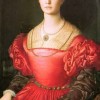
Jill R. Ehnenn, “On Art Objects and Women’s Words: Ekphrasis in Vernon Lee (1887), Graham R. Tomson (1889), and Michael Field (1892)”
Studies of women’s ekphrasis prior to modernism have, so far, tended to focus on individual women writers rather than attempt to identify trends that female authors from a particular time period might share. This essay intervenes in this gap in the scholarship by analyzing ekphrastic prose and poetry by Vernon Lee, Graham R. Tomson, and the co-authors who wrote as Michael Field. As female Aesthetes well-versed in art history and art criticism, as well as contemporary market practices, these nineteenth-century women writers anticipate today’s feminist theorists in the ways in which they were quite conscious of woman’s role as art object and the various functions of that role.
Here I examine Vernon Lee’s somewhat well-known novella Amour Dure (1887) as a foundational case study and then turn to two considerably lesser studied poems: Graham R. Tomson’s “A Silhouette” (1889) and Michael Field’s “Saint Katharine of Alexandria” (1892), for which I also identify the long-lost ekphrastic referent. These three texts all demonstrate how a specific form of aesthetic intertextuality—ekphrastic representational friction—operates as a powerful vehicle for early feminist criticism. In the examples I discuss, gendered critiques drive representational friction between the word, the visual medium, and its original referent—slippages that these art-savvy authors would have easily recognized and had opinions about in the work of others, and intentionally created and/or appropriated in their own work. Importantly, I also argue that a helpful way to think about ekphrastic writing by women writers associated with nineteenth-century British Aestheticism is to consider representational friction with particular regard to how their texts treat objects—seemingly unimportant objects—associated with their subjects.
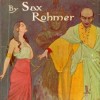
Shanyn Fiske, “Modeling Masculinity: Engendering the Yellow Peril in Fu-Manchu and Thomas Burke’s Limehouse Nights”
This entry deals with the event of the Yellow Peril, which generated fears of “Chinamen” as sexual predators, savage murderers, and criminal masterminds plotting world domination. Curiously, while these images lend Chinese men an aura of powerful virility, popular fiction credited with sensationalizing the Yellow Peril often depicted them as asexual or effeminate. Focusing on the first three novels of Sax Rohmer’s Fu-Manchu series and Thomas Burke’s Limehouse Nights (1916), I challenge the common critical assumption that the feminization or desexualization of Chinese men served to symbolically disempower a political threat. Instead, I suggest that in their interactions with their white counterparts, effeminized and / or desexualized Chinese male characters highlight problems in turn-of-the-century reconfigurations of masculinity. Such problems included recalibrating the Victorian balance between gentlemanly restraint and soldierly aggression in an unstable imperial context; redefining a sense of autonomy in a mechanized world; and renegotiating gender relations in a feminist environment. More broadly, I venture that the critical apparatus of Orientalism, which a number of theorists have applied to Rohmer’s works, is inadequate in explaining the complex interactions between Chinese and Britons in the early twentieth century. In examining the entangled racial and sexual tensions in these works, this entry historicizes the Yellow Peril within a broader context of Western male self-fashioning.
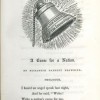
Denae Dyck and Marjorie Stone, “The ‘Sensation’ of Elizabeth Barrett Browning’s Poems before Congress (1860): Events, Politics, Reception”
Elizabeth Barrett Browning’s Poems before Congress paradoxically addresses a political event that never took place: a meeting of European powers to discuss the “Italian question” planned for January of 1860. Nevertheless, the collection addresses several momentous historical developments, including the Second Italian War of Independence in 1859, the intervention of Napoleon III of France in the Italian struggle, and the international conflict his intervention precipitated. Indeed, the book’s publication and the sensation it created in themselves constitute a plurality of events, since the collection appeared under differing titles in England and America and encountered differing responses in each country. Contrary to the still dominant critical view that the volume was almost universally denounced, its reception was shaped by diverse locations, shifting chronological contexts, and conflicting political affiliations. Close analysis of the reviews underscores the importance of these wider contexts, which influence what otherwise appear to be primarily literary or aesthetic judgements. At the same time, analysis of varying responses to not only “A Curse for a Nation” but also “Napoleon III in Italy” and other poems in the volume demonstrates a number of recurring points of contention. These include the collection’s title, the politics of interventions across national borders, English liberalism, the nature of democracy, cosmopolitanism versus nationalism, women writers in relation to politics, poetic form, and, most of all, EBB’s representation of Napoleon III—the issue that is front and centre in most of the 1860s reviews and that shaped, in turn, reactions to all the rest.
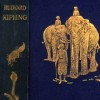
Mario Ortiz-Robles, “Animal Acts: 1822, 1835, 1849, 1850, 1854, 1876, 1900”
What does the history of animal rights have to tell us about Victorian Britain – and how do legislative gains, specifically Parliamentary Acts, appear when read in tandem with theatrical performances and literary depictions of animals? This article reads the former category alongside the latter two, paying particular attention to how artistic representations of animals, including Rudyard Kipling’s The Jungle Book, blur the lines between human and animal behavior. In doing so, it sheds light on how animals were figured as part of a racialized discourse, using Foucault’s notion of biopower to help frame the complex ways animal rights, and animalism, were portrayed in politics and culture.
